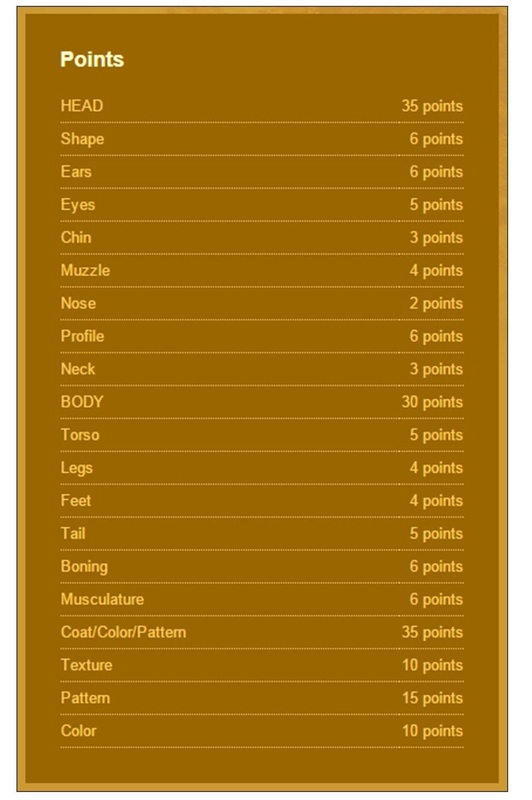TICA Bengal Standard
Bengals have three accepted divisions for Championship competition. These are Brown, Silver and the three Snow colors, (Seal Sepia, Seal Mink, and Seal Lynx Point). Within each color division are two accepted pattern types, Spotted and Marble.
Colors
Brown Tabby, Seal Sepia Tabby, Seal Mink Tabby, Seal Lynx Point,
Black Silver Tabby, Seal Silver Sepia Tabby, Seal Silver Mink Tabby, Seal Silver Lynx Point. Spotted or Marbled Patterns only HeadShape
Broad modified wedge with rounded contours. Longer than it is wide. Slightly small in proportion to body, but not to be taken to flows into the neck. Allowance to be made for jowls in adult males. Overall look of the head should be as distinct from the domestic cat as possible. Ears Medium to small, relatively short, with wide base and rounded tips. Set as much on side as top of head, following the contour of the face in the frontal view, and pointing forward in the profile view. Light horizontal furnishings acceptable; but lynx tipping undesirable. Eyes Oval, almost round. Large, but not bugged. Set wide apart, back into face, and on slight bias toward base of ear. Eye color independent of coat color except in the lynx points. The more richness and depth of color the better. Chin Strong chin, aligns with tip of nose in profile. Muzzle Full and broad, with large, prominent whisker pads and high, pronounced cheekbones. Slight muzzle break at the whisker pads. Nose Large and wide; slightly puffed nose leather. Profile Curve of the forehead should flow into the bridge of the nose with no break. Bridge of nose extends above the eyes; the line of the bridge extends to the nose tip, making a very slight, to nearly straight, concave curve. Neck Long, substantial, muscular; in proportion to the head and body. BodyTorso
Long and substantial, not oriental or foreign. Medium to large (but not quite as large as the largest domestic breed). Legs Medium length, slightly longer in the back than in the front. Feet Large, round, with prominent knuckles. Tail Medium length, thick, tapered at end with rounded tip. Boning Sturdy, firm; never delicate. Musculature Very muscular, especially in the males, one of the most distinguishing features. Coat/Color/PatternLength
Short to medium. Allowance for slightly longer coat in kittens. Texture Dense and luxurious, close-lying, unusually soft and silky to the touch. Patterns: Spotted or marbled. Spotted Spots shall be random, or aligned horizontally. Rosettes showing two distinct colors or shades, such as paw print shaped, arrowhead shaped, doughnut or half-doughnut shaped or clustered are preferred to single spotting but not required. Contrast with ground color must be extreme, giving distinct pattern and sharp edges. Strong, bold chin strap and mascara markings desirable. Virtually white undersides and belly desirable. Blotchy horizontal shoulder streaks, spotted legs and spotted or rosetted tail are desirable. Belly must be spotted. Marbled See TICA Uniform Color Description (74.1.1.2.1). Colors Brown Tabby: All variations of brown are allowed; however, a high degree of rufousing is preferred. Markings various shades of brown to black. Light spectacles encircling the eyes and a virtually white ground color on the whisker pads, chin, chest, belly and inner legs is desirable. Seal Sepia Tabby, Seal Mink Tabby & Seal Lynx Point Tabby Pattern can be various shades of brown. There should be very little or no difference between the color of the body (pattern) markings and point color. |
General DescriptionThe goal of the Bengal breeding program is to create a domestic cat which has physical features distinctive to the small forest-dwelling wildcats, and with the loving, dependable temperament of the domestic cat. Keeping this goal in mind, judges shall give special merit to those characteristics in the appearance of the Bengal which are distinct from those found in other domestic cat breeds.
A Bengal cat is an athletic animal, alert to its surroundings; a friendly, curious, confident cat with strength, agility, balance and grace. It is a medium to large cat which exhibits a very muscular and solid build. Its wide nose with prominent whisker pads and large oval, almost round eyes in a slightly small head enhance the wild appearance and expressive nocturnal look. Its very slight, to nearly straight, concave profile and relatively short ears with wide base and rounded tips add to the Bengal’s distinctive and unique appearance. The short, dense coat has a uniquely soft and silky feel. The coat may be glittered or not glittered, with neither type to be given preference. A thick, low-set, medium-length tail adds balance to the cat. Allowances Smaller size, in balanced proportion, of females. Slightly longer coat in kittens. Jowls in adult males. Eyes slightly almond shaped. Mousy undercoat. Penalize Spots on body running together vertically forming a mackerel tabby pattern on spotted cats; circular bulls-eye pattern on marbled cats; substantially darker point color (as compared to color of body markings) in Seal Sepia, Seal Mink, or Seal Lynx Point cats. Any distinct locket on the neck, chest, abdomen or any other area. Withhold All Awards (WW) Belly not spotted. Paw pads not consistent with their color group description, or paw pads not all of the same color. Temperament must be unchallenged; any sign of definite challenge shall disqualify. The cat may exhibit fear, seek to flee, or generally complain aloud but may not threaten to harm. In accordance with Show Rules, ARTICLE SIXTEEN, the following shall be considered mandatory disqualifications:
Acknowledgment
Thank you to Sierra Gold Bengals for providing the information regarding TICA Bengal Stands herein. |
